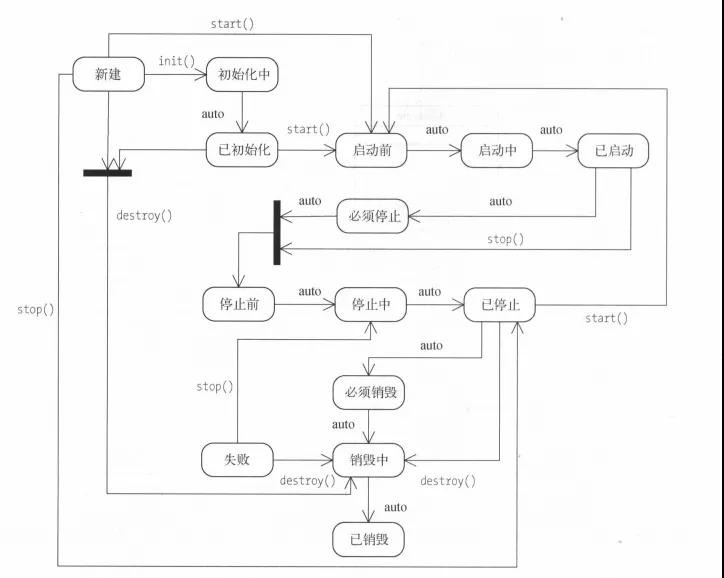本文转载自微信公众号「Java极客技术」,作者鸭血粉丝 。转载本文请联系Java极客技术公众号。
序言
Tomcat的生命周期管理的话,我们不能总是从书中获取那些知识,而是结合实践,然后综合书中的内容,进行一层一层的深入分析,这样对自己记忆和理解都能更加的透彻。
启动的时候的
大家可以随便找一个zip版本的Tomcat,然后直接启动起来,我们来看看是个什么样子的,
- 一月 11, 2021 10:16:24 上午 org.apache.coyote.AbstractProtocol init
- 信息: Initializing ProtocolHandler ["http-bio-8080"]
- 一月 11, 2021 10:16:24 上午 org.apache.coyote.AbstractProtocol init
- 信息: Initializing ProtocolHandler ["ajp-bio-8009"]
- 一月 11, 2021 10:16:24 上午 org.apache.catalina.startup.Catalina load
- 信息: Initialization processed in 470 ms
- 一月 11, 2021 10:16:24 上午 org.apache.catalina.core.StandardService startInternal
- 信息: Starting service Catalina
- 一月 11, 2021 10:16:24 上午 org.apache.catalina.core.StandardEngine startInternal
- 信息: Starting Servlet Engine: Apache Tomcat/7.0.88
- 一月 11, 2021 10:16:24 上午 org.apache.catalina.startup.HostConfig deployDirectory
大家看到这个启动过程之后,在联想一下之前的文章中的Tomcat的启动流程,是不是又感觉有点那个味道了,load,然后start,最后然后stop了。
划重点1:Lifecycle
在之前的文章中,我们提到了Lifecycle, 而Tomcat也就是通过Lifecycle接口统一管理生命周期,所有有生命周期的组件都要实现Lifecycle接口,以便提供一致的机制去启动和停止组件。
那么我们就来分析一下这个Lifecycle接口里面都包含了哪些内容,大家可以直接去tomcat的包中的catalina的jar下面去寻找看一下,
- 定义了13个String类型的变量
- 定义了3个管理监听器的方法
- 定义了4个生命周期
- 定义了2个获取当前状态的方法
那么我们先说这个13个变量:
- String BEFORE_INIT_EVENT = "before_init";
- String AFTER_INIT_EVENT = "after_init";
- String START_EVENT = "start";
- String BEFORE_START_EVENT = "before_start";
- String AFTER_START_EVENT = "after_start";
- String STOP_EVENT = "stop";
- String BEFORE_STOP_EVENT = "before_stop";
- String AFTER_STOP_EVENT = "after_stop";
- String AFTER_DESTROY_EVENT = "after_destroy";
- String BEFORE_DESTROY_EVENT = "before_destroy";
- String PERIODIC_EVENT = "periodic";
- String CONFIGURE_START_EVENT = "configure_start";
- String CONFIGURE_STOP_EVENT = "configure_stop";
这13个变量是什么意思呢?在《Tomcat架构解析》一书中说到,这些常量信息用于LifecycleEvent事件的type属性中,作用是区分组件发出的LifecycleEvent事件时的状态(如初始化前、启动前、启动中等)。这种设计方法可以让多种状态都发送同一种类型的时间,然后用其中的一个属性类区分状态而不用定义多种事件。
其实大家可以根据变量的名字就能看出来,初始化前,初始化后,启动,启动前,启动后。。。。说的在直白一点 ,就是为了表示组件发出时的状态而已。
而三个管理监听的方法又是什么呢?
- void addLifecycleListener(LifecycleListener var1);
- LifecycleListener[] findLifecycleListeners();
- void removeLifecycleListener(LifecycleListener var1);
而这个三个监听器也分别就是用来添加,查找和删除LifecycleListener类型的监听器。这里面是三个接口,具体实现一会我们去子类里面找,在这里先知道有这么个东西就行,下面就会直接分析。
4个生命周期
这个就肯定很简单了,比如像我们都知道在Servlet的生命周期一样,init,start,stop,destroy,初始化,启动,停止,销毁,
- void init() throws LifecycleException;
- void start() throws LifecycleException;
- void stop() throws LifecycleException;
- void destroy() throws LifecycleException;
2个获取状态的方法
- LifecycleState getState();
- String getStateName();
毕竟这个Lifecycle是一个接口,它并不是具体的实现类,我们想要了解这个,那么就一定得去具体的实现类里面去找寻这个内容,那么他的实现类是什么呢?来了来了,它来了,LifecycleBase
LifecycleBase
LifecycleBase是抽象类,是tomcat中所有组件类的基类,他实现了Lifecycle,但是Tomcat下的很多子类也同样的继承了它,所以他也是非常重要的,
- public abstract class LifecycleBase implements Lifecycle {
- private LifecycleSupport lifecycle = new LifecycleSupport(this);
- // 源组件的当前状态,不同状态触发不同事件
- private volatile LifecycleState state;
- public LifecycleBase() {
- this.state = LifecycleState.NEW;
- }
- }
在这里我们还要注意一下这个LifecycleSupport类,LifecycleSupport中定义了一个LifecycleListener数组类型的属性来保存所有的监听器,然后在里面分别定义了添加,删除,查找,执行监听器的方法,不信的话,我们来看看,毕竟这个类放在这里先new出来也是有一定道理的。
- public final class LifecycleSupport {
- private Lifecycle lifecycle = null;
- private LifecycleListener[] listeners = new LifecycleListener[0];
- private final Object listenersLock = new Object();
- public LifecycleSupport(Lifecycle lifecycle) {
- this.lifecycle = lifecycle;
- }
- public void addLifecycleListener(LifecycleListener listener) {
- Object var2 = this.listenersLock;
- synchronized(this.listenersLock) {
- LifecycleListener[] results = new LifecycleListener[this.listeners.length + 1];
- for(int i = 0; i < this.listeners.length; ++i) {
- results[i] = this.listeners[i];
- }
- results[this.listeners.length] = listener;
- this.listeners = results;
- }
- }
- public LifecycleListener[] findLifecycleListeners() {
- return this.listeners;
- }
- public void fireLifecycleEvent(String type, Object data) {
- LifecycleEvent event = new LifecycleEvent(this.lifecycle, type, data);
- LifecycleListener[] interested = this.listeners;
- for(int i = 0; i < interested.length; ++i) {
- interested[i].lifecycleEvent(event);
- }
- }
- public void removeLifecycleListener(LifecycleListener listener) {
- Object var2 = this.listenersLock;
- synchronized(this.listenersLock) {
- int n = -1;
- for(int i = 0; i < this.listeners.length; ++i) {
- if (this.listeners[i] == listener) {
- n = i;
- break;
- }
- }
- if (n >= 0) {
- LifecycleListener[] results = new LifecycleListener[this.listeners.length - 1];
- int j = 0;
- for(int i = 0; i < this.listeners.length; ++i) {
- if (i != n) {
- results[j++] = this.listeners[i];
- }
- }
- this.listeners = results;
- }
- }
- }
- }
话不多说,我们继续往下,它的生命周期方法又是什么呢?这才是今天的重点。之前我们就说生命周期包含了哪些内容,从init开始,然后start,然后stop以及最后的destroy方法,在实现类里面表现的那是淋漓尽致。
init方法
- public final synchronized void init() throws LifecycleException {
- //这里表示只有NEW状态下是可以使用的,
- if (!this.state.equals(LifecycleState.NEW)) {
- this.invalidTransition("before_init");
- }
- //在这里通过不同的状态,然后去触发不同的事件,
- try {
- //设置生命周期状态为INITIALIZING
- this.setStateInternal(LifecycleState.INITIALIZING, (Object)null, false);
- //执行方法
- this.initInternal();
- //设置生命周期状态为INITIALIZED
- this.setStateInternal(LifecycleState.INITIALIZED, (Object)null, false);
- } catch (Throwable var2) {
- ExceptionUtils.handleThrowable(var2);
- this.setStateInternal(LifecycleState.FAILED, (Object)null, false);
- throw new LifecycleException(sm.getString("lifecycleBase.initFail", new Object[]{this.toString()}), var2);
- }
- }
start方法
- public final synchronized void start() throws LifecycleException {
- //在这里验证生命周期状态,状态是这三种状态的是为不可用状态STARTING_PREP,STARTING,STARTED
- if (!LifecycleState.STARTING_PREP.equals(this.state) && !LifecycleState.STARTING.equals(this.state) && !LifecycleState.STARTED.equals(this.state)) {
- //如果是NEW状态,执行init方法
- if (this.state.equals(LifecycleState.NEW)) {
- this.init();
- //如果是FAILED状态,那么执行stop方法
- } else if (this.state.equals(LifecycleState.FAILED)) {
- this.stop();
- //如果是INITIALIZED状态,那么就会告诉你是个非法的操作
- } else if (!this.state.equals(LifecycleState.INITIALIZED) && !this.state.equals(LifecycleState.STOPPED)) {
- this.invalidTransition("before_start");
- }
- try {
- //设置启动状态为 STARTING_PREP
- this.setStateInternal(LifecycleState.STARTING_PREP, (Object)null, false);
- this.startInternal();
- //这里就非常的严谨,他会在启动之后,继续去看状态是什么,保证启动成功
- if (this.state.equals(LifecycleState.FAILED)) {
- this.stop();
- } else if (!this.state.equals(LifecycleState.STARTING)) {
- this.invalidTransition("after_start");
- } else {
- this.setStateInternal(LifecycleState.STARTED, (Object)null, false);
- }
- } catch (Throwable var2) {
- ExceptionUtils.handleThrowable(var2);
- this.setStateInternal(LifecycleState.FAILED, (Object)null, false);
- throw new LifecycleException(sm.getString("lifecycleBase.startFail", new Object[]{this.toString()}), var2);
- }
- } else {
- if (log.isDebugEnabled()) {
- Exception e = new LifecycleException();
- log.debug(sm.getString("lifecycleBase.alreadyStarted", new Object[]{this.toString()}), e);
- } else if (log.isInfoEnabled()) {
- log.info(sm.getString("lifecycleBase.alreadyStarted", new Object[]{this.toString()}));
- }
- }
- }
stop方法
- public final synchronized void stop() throws LifecycleException {
- //同样的,和上面一样,三种状态下不可执行
- if (!LifecycleState.STOPPING_PREP.equals(this.state) && !LifecycleState.STOPPING.equals(this.state) && !LifecycleState.STOPPED.equals(this.state)) {
- //如果是NEW状态,状态直接修改为STOPPED
- if (this.state.equals(LifecycleState.NEW)) {
- this.state = LifecycleState.STOPPED;
- } else {
- //如果不是这2中状态,那么就直接异常
- if (!this.state.equals(LifecycleState.STARTED) && !this.state.equals(LifecycleState.FAILED)) {
- this.invalidTransition("before_stop");
- }
- try {
- if (this.state.equals(LifecycleState.FAILED)) {
- this.fireLifecycleEvent("before_stop", (Object)null);
- } else {
- this.setStateInternal(LifecycleState.STOPPING_PREP, (Object)null, false);
- }
- this.stopInternal();
- if (!this.state.equals(LifecycleState.STOPPING) && !this.state.equals(LifecycleState.FAILED)) {
- this.invalidTransition("after_stop");
- }
- this.setStateInternal(LifecycleState.STOPPED, (Object)null, false);
- } catch (Throwable var5) {
- ...
- } finally {
- ...
- }
- }
- } else {
- ...
- }
- }
destroy方法
- public final synchronized void destroy() throws LifecycleException {
- //如果状态是启动失败的,也就是FAILED,那么会直接去调用stop方法,
- if (LifecycleState.FAILED.equals(this.state)) {
- try {
- this.stop();
- } catch (LifecycleException var3) {
- log.warn(sm.getString("lifecycleBase.destroyStopFail", new Object[]{this.toString()}), var3);
- }
- }
- //如果是这两种状态DESTROYING、DESTROYED,那么就不再进行执行了,直接进行return
- if (!LifecycleState.DESTROYING.equals(this.state) && !LifecycleState.DESTROYED.equals(this.state)) {
- if (!this.state.equals(LifecycleState.STOPPED) && !this.state.equals(LifecycleState.FAILED) && !this.state.equals(LifecycleState.NEW) && !this.state.equals(LifecycleState.INITIALIZED)) {
- this.invalidTransition("before_destroy");
- }
- try {
- this.setStateInternal(LifecycleState.DESTROYING, (Object)null, false);
- this.destroyInternal();
- this.setStateInternal(LifecycleState.DESTROYED, (Object)null, false);
- } catch (Throwable var2) {
- ExceptionUtils.handleThrowable(var2);
- this.setStateInternal(LifecycleState.FAILED, (Object)null, false);
- throw new LifecycleException(sm.getString("lifecycleBase.destroyFail", new Object[]{this.toString()}), var2);
- }
- } else {
- ...
- }
- }
阿粉在其中精简了一些代码,如果大家有兴趣的可以自己去翻一下源码,然后自己去看一下,这样对比出来才有效果。
总结
其实就是通过不同的状态转变,然后相应的去调用init、start、stop、destroy方法,然后提供所有Tomcat组件的生命周期管理。
上图就是接口状态不同情况执行不同方法的图,图片来自《Tomcat架构解析》
文献参考
《深入剖析Tomcat》 《Tomcat架构解析》 《Servlet/JSP深入详解》


































